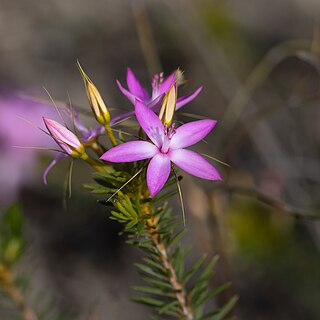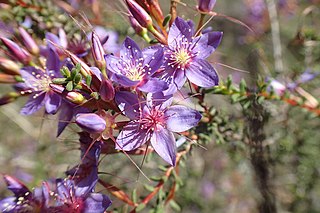
Calytrix is a genus of about 83 species of flowering plants, commonly known as star flowers, in the family Myrtaceae and is endemic to Australia. Plants in the genus Calytrix are small to large shrubs with small, spreading and more or less round leaves, the flowers arranged singly in leaf axils. The flowers are bisexual with 5 overlapping sepals with a long awn, and many stamens.

Calytrix depressa is a species of flowering plant in the myrtle family Myrtaceae and is endemic to the south-west of Western Australia. It is a glabrous shrub with linear to lance-shaped leaves and mauve to violet or yellow flowers with 35 to 75 stamens in several rows.

Calytrix aurea is a species of flowering plant in the myrtle family Myrtaceae and is endemic to the south-west of Western Australia. It is a shrub with elliptic, lance-shaped or linear leaves and clusters of yellow flowers with 25 to 55 yellow stamens in several rows.
Calytrix amethystina is a species of flowering plant in the myrtle family Myrtaceae and is endemic to inland areas of Western Australia. It is a glabrous shrub with egg-shaped to oblong or more or less round leaves and clusters of purple to violet flowers with about 35 to 80 white stamens in several rows.

Calytrix acutifolia is a species of flowering plant in the myrtle family Myrtaceae and is endemic to south-west of Western Australia. It is a slender, openly-branched shrub with linear to lance-shaped leaves and clusters of white, cream-coloured or yellow flowers with 40 to 85 white stamens in several rows.

Calytrix angulata, commonly known as yellow starflower, is a species of flowering plant in the myrtle family Myrtaceae and is endemic to the south-west of Western Australia. It is a shrub with linear to egg-shaped leaves and clusters of yellowish-cream coloured flowers with 30 to 40 yellow stamens in several rows.

Calytrix asperula, commonly known as brush starflower, is a species of flowering plant in the myrtle family Myrtaceae and is endemic to the south of Western Australia. It is a mostly glabrous shrub with linear to narrowly elliptic leaves and cream-coloured to yellow flowers with 40 to 60 yellow stamens in several rows.
Calytrix breviseta is a species of flowering plant in the myrtle family Myrtaceae and is endemic to the south-west of Western Australia. It is a more or less glabrous shrub with egg-shaped, elliptic, lanceolate, oblong or linear leaves and clusters of purple flowers with about 25 to 65 white stamens in several rows, becoming reddish-purple as they age.

Calytrix creswellii is a species of flowering plant in the myrtle family Myrtaceae and is endemic to inland areas of Western Australia. It is a spreading, glabrous shrub usually with egg-shaped leaves with the narrower end towards the base, and clusters of white flowers with about 40 to 55 white or yellow stamens in several rows.

Calytrix decandra, commonly known as pink starflower, is a species of flowering plant in the myrtle family Myrtaceae and is endemic to the south of Western Australia. It is a semi-prostrate, glabrous shrub with linear to narrowly elliptic leaves and pink, mauve or magenta flowers with usually 10 stamens in a single row.
Calytrix ecalycata is a species of flowering plant in the myrtle family Myrtaceae and is endemic to the south-west of Western Australia. It is a slender, erect shrub with linear to narrowly elliptic leaves, and yellow flowers with 35 to 50 stamens in several rows.
Calytrix erosipetala is a species of flowering plant in the myrtle family Myrtaceae and is endemic to inland areas of Western Australia. It is a glabrous shrub with spreading lance-shaped to egg-shaped or linear leaves, and white to pink flowers with about 18 to 24 stamens in a single row.

Calytrix flavescens, commonly known as summer starflower, is a species of flowering plant in the myrtle family Myrtaceae and is endemic to the south-west of Western Australia. It is a shrub with linear to narrowly elliptic leaves, and yellow flowers with about 35 to 60 stamens in several rows.

Calytrix fraseri, commonly known as pink summer calytrix or pink summer starflower, is a species of flowering plant in the myrtle family Myrtaceae and is endemic to the south-west of Western Australia. It is a shrub with oblong, linear or elliptic leaves with the narrower end towards the base, and pink, cerise or pinkish purple flowers with about 35 to 55 stamens in several rows.

Calytrix glutinosa is a species of flowering plant in the myrtle family Myrtaceae and is endemic to the south-west of Western Australia. It is a more or less glabrous shrub with linear leaves and clusters of pink to mauve flowers with about 10 to 20 white stamens in one or two rows, becoming reddish-purple as they age.
Calytrix gypsophila, commonly known as gypsum fringle-myrtle, is a species of flowering plant in the myrtle family Myrtaceae and is endemic to southern continental Australia. It is a glabrous shrub with oblong, linear or lance-shaped leaves with the narrower end towards the base, and white flowers with 25 to 40 stamens in a single row.

Calytrix violacea is a species of flowering plant in the myrtle family, Myrtaceae and is endemic to the southwest of Western Australia. It is a shrub with linear to narrowly egg-shaped leaves with the narrower end towards the base, and purple, star-shaped flowers.

Stenanthemum emarginatum is a species of flowering plant in the family Rhamnaceae and is endemic to the southwest of Western Australia. It is a spreading to prostrate shrub with sparsely hairy young stems, narrowly fan-shaped to linear leaves and densely, shaggy-hairy heads of white or cream-coloured flowers.
Calytrix cravenii is a species of flowering plant in the myrtle family Myrtaceae and is endemic to the south-west of Western Australia. It is an erect, open shrub with linear leaves and clusters of white flowers with 18 to 29 white stamens in several rows.
Calytrix gomphrenoides is a species of flowering plant in the myrtle family Myrtaceae and is endemic to the Kimberley region of Western Australia. It is a glabrous, multi-stemmed shrub with linear leaves and white flowers turning pink as they age, with 16 to 18 stamens in a single row.













